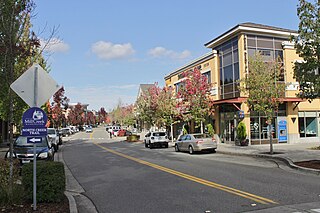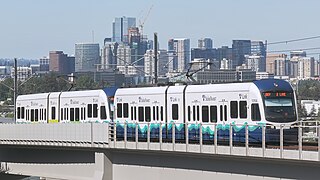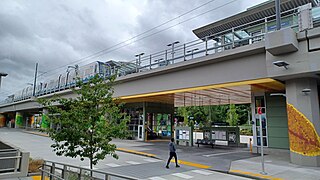
Issaquah is a city in King County, Washington, United States. The population was 40,051 at the 2020 census. Located in a valley and bisected by Interstate 90, the city is bordered by the Sammamish Plateau to the north and the "Issaquah Alps" to the south. It is home to the headquarters of the multinational retail company Costco Wholesale Corporation. Issaquah is included in the Seattle metropolitan area.

Sammamish is a city in King County, Washington, United States. The population was 67,455 at the 2020 census. Located on a plateau, the city is bordered by Lake Sammamish to the west and the Snoqualmie Valley to the east. Sammamish is situated 20 miles east of Seattle, is a member of the Eastside, and is a part of the Seattle metropolitan area. Incorporated in 1999, Sammamish is an affluent community and has been ranked as one of the wealthiest cities in Washington.

Marysville is a city in Snohomish County, Washington, United States, part of the Seattle metropolitan area. The city is located 35 miles (56 km) north of Seattle, adjacent to Everett on the north side of the Snohomish River delta. It is the second-largest city in Snohomish County after Everett, with a population of 70,714 at the time of the 2020 U.S. census. As of 2015, Marysville was also the fastest-growing city in Washington state, growing at an annual rate of 2.5 percent.

Mill Creek is a city in Snohomish County, Washington, United States. It is located between the cities of Everett and Lynnwood, approximately 20 miles (32 km) northeast of Seattle. The city has a population of 20,926 as of the 2020 census. The city lies along State Route 527 and North Creek, a tributary of the Sammamish River, on the east side of Interstate 5.

Bothell is a city in King and Snohomish counties in the U.S. state of Washington. It is part of the Seattle metropolitan area, situated near the northeast end of Lake Washington in the Eastside region. It had a population of 48,161 residents as of the 2020 census.

Lake Sammamish is a freshwater lake 8 miles (13 km) east of Seattle in King County, Washington, United States. The lake is 7 miles (11 km) long and 1.5 miles (2 km) wide, with a maximum depth of 105 feet (32 m) and a surface area of 8 sq mi (21 km2). It lies east of Lake Washington and west of the Sammamish Plateau, and stretches from Issaquah in the south to Redmond in the north. At Issaquah it is fed by Issaquah Creek, and at Redmond it drains to Lake Washington via the Sammamish River, named after the native people who once lived along its entire length.

State Route 520 (SR 520) is a state highway and freeway in the Seattle metropolitan area, part of the U.S. state of Washington. It runs 13 miles (21 km) from Seattle in the west to Redmond in the east. The freeway connects Seattle to the Eastside region of King County via the Evergreen Point Floating Bridge on Lake Washington. SR 520 intersects several state highways, including Interstate 5 (I-5) in Seattle, I-405 in Bellevue, and SR 202 in Redmond.

Naval Station Everett is a military installation located in the city of Everett, Washington, 25 miles (40 km) north of Seattle. The naval station, located on the city's waterfront on the northeastern end of Puget Sound, was designed as a homeport for a US Navy carrier strike group and opened in 1994. A separate Navy Support Complex is located in Smokey Point, 11 miles (18 km) north of Everett near Marysville, and houses a commissary, Navy Exchange, a college and other services.

Interstate 405 (I-405) is a north–south auxiliary Interstate Highway serving the Seattle region of Washington, United States. It bypasses Seattle east of Lake Washington, traveling through the Eastside area of King and Snohomish counties, providing an alternate route to I-5. The 30-mile (48 km) freeway serves the cities of Renton, Bellevue, Kirkland, and Bothell. I-405 terminates at I-5 in Tukwila and Lynnwood, and also intersects several major highways, including SR 167, I-90, SR 520, and SR 522.
Issaquah School District No. 411 is a public school district in King County, Washington. It is headquartered in Issaquah, Washington.
Klahanie is a planned community in Sammamish, Washington, United States. The population was 10,674 at the 2010 census. Prior to its annexation by the city of Sammamish in 2016, Klahanie was a census-designated place (CDP) in unincorporated King County.

State Route 202 (SR 202) is a state highway in the U.S. state of Washington, serving part of the Seattle metropolitan area. It runs southeasterly for 31 miles (50 km) in the Eastside region of King County, connecting Woodinville, Redmond, Fall City, and North Bend. The highway begins at SR 522 in Woodinville, intersects SR 520 in Redmond and SR 203 in Fall City, and terminates at Interstate 90 (I-90) in North Bend. The entire highway is designated as the Cascade Valleys Scenic Byway, a state scenic and recreational highway.

Lake Sammamish State Park is a park at the south end of Lake Sammamish, in King County, Washington, United States. The park, which is administered by the Washington State Park System, covers an area of 512 acres (0.80 sq mi) and has 6,858 feet (2,090 m) of waterfront; Issaquah Creek meets with Lake Sammamish within the park. It is a popular location for boating and watersport activities, such as waterskiing.

The 2 Line, also known as the East Link Extension, is a light rail line serving the Eastside region of the Seattle metropolitan area in the U.S. state of Washington. It is part of Sound Transit's Link light rail system and runs for 6.6 miles (10.6 km) in the cities of Bellevue and Redmond. The initial segment serves eight stations between South Bellevue and Redmond Technology stations and opened on April 27, 2024. The full line is scheduled to open in 2025 and is planned to include 18 miles (29 km) from west to east and serve twelve stations in Downtown Seattle, Mercer Island, Bellevue, and Redmond. The 2 Line will continue through the Downtown Seattle Transit Tunnel and share stations with the 1 Line through to Lynnwood City Center station.

South Bellevue station is an elevated light rail station located in Bellevue, Washington, United States, an eastern suburb of Seattle. It opened on April 27, 2024, as the western terminus of the 2 Line of Sound Transit's Link light rail system. The station has a park and ride garage with 1,500 stalls and bus service from King County Metro and Sound Transit Express.

Mark Douglas Mullet is an American businessman and politician of the Democratic Party. A moderate, he is a member of the Washington State Senate, representing the 5th Legislative District.

The Bellevue City Hall is a government office building and city hall in Bellevue, Washington. The current city hall, located in Downtown Bellevue, opened in 2006 after the $121 million renovation of a former Qwest data center. The data center, originally built for Pacific Northwest Bell in 1983, was acquired by the city government in 2002 for use by the Bellevue Police Department and later approved as the new city hall. It incorporates use of wood interiors and a terra cotta exterior that has been recognized with several design awards since its opening.

Kayak Point County Park is a county park near Warm Beach, in Snohomish County, Washington. The 670-acre (270 ha) park is located along Port Susan and includes a saltwater beach, a boat launch, a disc golf course, and public campgrounds. Kayak Point is the most popular county park in Snohomish County and is mainly visited for recreational fishing, crabbing, and birdwatching.
The Washington State Fire Training Academy is a firefighting training center near North Bend, Washington, United States. It is operated by the Washington State Patrol and includes classrooms, dormitories, and several simulation centers. The facility opened in 1984.


















